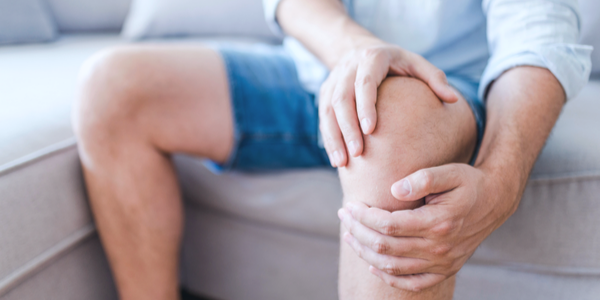
With arthritis being the number one cause of disability in the United States, and with over 50 million Americans living with it, there are more than likely rising questions.
What is arthritis? Is arthritis more than joint pain? How can one find arthritis relief?
Those questions and more are answered here, so read on to learn more about arthritis and how to navigate treatment options.
Common Types of Arthritis
Arthritis is not a single disease, but rather an umbrella term for joint pain and disease. Despite over 100 types, arthritis is still not well understood and varies related to its form.
While all affect the joints, they are named differently based on causes, populations they affect, and other key factors like the location they begin in the body. Osteoarthritis, rheumatoid arthritis, psoriatic arthritis, fibromyalgia, and gout are the most common types.
Autoimmune Arthritis
The most common form of this arthritis is rheumatoid arthritis, which is often abbreviated as RA. As its name suggests, in the case of autoimmune arthritis, the body begins attacking its own healthy cells in an attempt to stop the inflammation.
Gout
Gout is a form of inflammatory arthritis that often develops in those who cannot flush out uric acid in the blood. Uric acid is formed as the body breaks down purines, a substance found in the body and many foods.
If uric acid accumulates, it can cause crystals to form in the joints, especially in the feet, and result in extreme joint pain.
Infectious Arthritis
Also called septic arthritis in some cases, this kind of arthritis spreads from one joint of the body to another. It is often linked in scientific research to viral or bacterial infections that spread across the body.
Juvenile (Childhood) Arthritis
This type of arthritis affects children. Its symptoms sometimes mirror other conditions, and because a specific cause is unknown it can be hard to diagnose.
Osteoarthritis
Also recognized as degenerative arthritis, osteoarthritis is the most common type. Usually, it is linked to age or injuries from work or sports.
When cartilage (or the cushion on the ends of bones) wears away, bones rub against one another, which causes swelling and stiffness. Over time, affected joints can lose strength and pain can be intensified.
Psoriatic Arthritis
Psoriasis is a skin condition that causes cells to build up rapidly and results in red dry flakes on the skin's surface. Psoriatic arthritis (PsA) is similar to RA, where the immune system attacks healthy joints.
However, PsA is typically seen in individuals with psoriasis and can affect any joint found in the body along with other connective tissue, such as the heel.
Other
Fibromyalgia and lupus are related autoimmune conditions in which the joints are attacked. Several of the tools taught in the treatment of arthritis may also be helpful for these conditions.
Fibromyalgia involves nerve cells and results in neuronal imbalance. The changes in neurons often cause the brain to experience pain more sensitively and intensely. This causes widespread musculoskeletal pain that affects areas around the joints.
What Causes Arthritis?
Since arthritis often strikes an older population, many people are curious as to the cause (and if there is a way to prevent it). There are a couple of common causes thought to be linked to arthritis.
Research has found an association between arthritis and the following:
• Family history of arthritis
• Activities that repeatedly stress joints (i.e. job, sport)
• Certain autoimmune diseases
• Certain viral infections
Risk Factors For Arthritis
Some common factors that make arthritis more likely include age, lifestyle habits, sex, and weight.
When it comes to age, the risk of arthritis goes up as one gets older. Lifestyle factors, such as smoking or inactivity, can also increase the likelihood of arthritis with age. Women are also more likely to develop most kinds of arthritis.
Additionally, carrying excess weight can put stress on the joints and can lead to arthritis as well. Physically taxing jobs or sports can also put extra strain on the joints and cause excessive wear and tear.
When Arthritis Becomes Debilitating
The immune response that occurs with arthritis can be debilitating - not just around the joints but for the whole body. Noticing what symptoms the body is signaling is the first step to finding treatment.
Arthritis Symptoms
Common symptoms of arthritis include:
• Joint pain
• Irritation, inflammation, or redness
• Stiff joints
• Swelling
• Tenderness
Intense symptoms can lead to a reduced range of motion and make everyday activities, like writing or walking upstairs, very hard. Arthritis can lead to serious and painful situations, such as:
• Advanced cartilage breakdown
• Bone fractures
• Dislocations
• Ligament injuries
• Soft tissue inflammation
• Tendon injuries
While there is not a blood test to directly test for arthritis, a healthcare provider may test blood for proteins and other compounds that can indicate inflammation.
Can Arthritis Be Reversed?
There is no known cure for arthritis, and the disease cannot be reversed. It can, however, be managed so that symptoms are improved such as pain relief.
Identify Triggers And Flare-Ups
It is important to recognize when symptoms start to show. Sometimes they are tied to certain triggers, which could be an activity, food, or even the weather.
People with arthritis should try keeping symptoms or wellness journals so that symptoms can be charted and analyzed over time. This can be a helpful tool for patients and health care teams to discover together.
Aim for Lifestyle Modification
Healthy habits can do a world of good for aching joints. Lifestyle modifications to make include:
• Stop smoking
• Start low-impact exercise (non-weight bearing)
• Lose weight as recommended
• Maintain a healthy weight
• Reduce the risk of injury
• Adjust a routine by working with an occupational therapist
• Consider adaptive equipment
Choose the Right Medication
There may be a certain kind of medication that can help those with arthritis to mitigate a flare-up. Some of these medications are over-the-counter, while other topical pain relievers or rubs may need to be prescribed.
Try Physical Therapy
While some movements may be painful, other movements may actually get the blood flowing and alleviate some of the pain. Activity modifications can be made to make physical activity/exercising with arthritis safer.
Special splints, braces, or hot/cold therapies may be recommended to help stabilize joints, too.
Get Surgery as Advised
In severe cases, surgery may be suggested. A healthcare provider may recommend fusion, where two bones are permanently fused to immobilize a joint that is causing pain with every movement.
Joint replacement may also be an option and is a surgery where the damaged joint is replaced with a non-arthritic, artificial joint.
Arthritis Recap
Arthritis can be a tricky disease, but there are effective treatments. Talk to a healthcare provider about possible options, including lifestyle modifications that can make life easier.
Ease arthritis pain, stiffness, and other symptoms without sacrificing quality of life!
References:
Arthritis Types. Centers for Disease Control and Prevention. https://www.cdc.gov/arthritis/basics/types.html.
Arthritis. Cleveland Clinic Staff. Published April 25, 2021. https://my.clevelandclinic.org/health/diseases/12061-arthritis.
Arthritis. MedlinePlus. Published December 14, 2021. https://medlineplus.gov/arthritis.html.
Ricciotti H, Golen T. Is osteoarthritis reversible? Harvard Health Publishing. Published March 1, 2020. https://www.health.harvard.edu/diseases-and-conditions/is-osteoarthritis-reversible.






